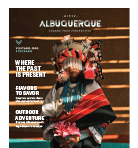Visit Albuquerque prohibits users from downloading images from our website.
Please use our media library for downloadable images and usage rights.
See More in this Section:
Western Legends
The western states in the 1800s were filled with colorful characters, from legendary frontiersmen to notorious outlaws. New Mexico was home to many of them, including Kit Carson, a rancher, trapper, soldier and all-around outdoorsman whose name has become synonymous with the American West.
Born on Christmas Eve in 1809, Carson spent most of his early childhood in Boone's Lick, Missouri. His father died when he was nine years old, and the need to work prevented Kit from ever receiving an education. He was apprenticed to a saddle-maker when he turned 14, but left home for the Santa Fe, New Mexico area in 1826.
From about 1828 to 1831, Carson used Taos, New Mexico, as a base camp for repeated fur-trapping expeditions that often took him as far west as California. As was the case with many white trappers, Carson became somewhat integrated into the Indian world; he traveled and lived extensively among Indians, and his first two wives were Arapahoe and Cheyenne women. Carson was unusual among trappers for his self-restraint and temperate lifestyle. "Clean as a hound's tooth," according to one acquaintance, and a man whose "word was as sure as the sun comin' up," he was noted for an unassuming manner and implacable courage.
In 1842, while returning to Missouri to visit his family, Carson happened to meet John C. Fremont, who soon hired him as a guide. Over the next several years, Carson helped guide Fremont to Oregon and California, and through much of the Central Rocky Mountains and the Great Basin. His service with Fremont, celebrated in Fremont's widely-read reports of his expeditions, quickly made Kit Carson a national hero, presented in popular fiction as a rugged mountain man capable of superhuman feats. Carson fought in the Mexican-American war in 1846, and played a prominent role in the Civil War in New Mexico. He helped organize the New Mexico volunteer infantry, which saw action at Valverde in 1862.
Most of Carson's military actions, however, were directed against the Navajo Indians, many of whom had refused to be confined upon a distant reservation set up by the government. Beginning in 1863 Carson waged a brutal economic war against the Navajo, marching through the heart of their territory to destroy their crops, orchards and livestock. In 1864 most surrendered to Carson, who forced nearly 8,000 Navajo men, women and children to take what came to be called the Long Walk of 300 miles from Arizona to Fort Sumner, New Mexico. The Navajo remained there in disease-ridden confinement until 1868, when a treaty was signed between the United States and the Navajo, giving them the 3.5 million-acre reservation in the Four Corners area that includes parts of New Mexico, Arizona, Utah and Colorado.
After the Civil War, Carson moved to Colorado in hopes of expanding his ranching business. He died there in 1868, and the following year his remains were moved to a small cemetery near his old home in Taos.
Another legendary figure was Billy the Kid, a teenage outlaw who may be America's most famous juvenile delinquent. Billy the Kid's real name was William Henry McCarty. It's estimated that he was born around 1860 or 1861, possibly in New York. History first traces the Kid as a youngster in Indiana in the late 1860s and then in Wichita, Kansas in 1870. By 1871, his widowed mother Catherine McCarty was diagnosed with tuberculosis and was told to move to a climate that was warmer and drier. The family packed up and moved to New Mexico.
On March 1, 1873 in Santa Fe, Catherine McCarty married a man named William Antrim. Catherine continued to be in failing health and she died on September 16, 1874. The Kid was placed in a foster home and his stepfather left for Arizona. Fleeing his foster family, the Kid made his way to Arizona where his stepfather was living, but when found, Antrim told the Kid to leave. All alone in a strange desert, the Kid wandered from one ranch to another to find work. For the next two years he tramped around as a ranch hand and gambler.
By the age of 16 the Kid was an outlaw for killing a man in Camp Grant, Arizona. He didn't stick around to face murder charges, leaving Arizona for Lincoln County, New Mexico where he found employment with an Englishman entrepreneur named John Tunstall. Around this time, the Kid changed his name to William H. Bonney, but his friends called him "Kid."
Ominously, a bitter feud was brewing between the Kid's employer, Tunstall, and a rival, James Dolan, which would be famously known as the Lincoln County War. Tensions were high and in 1878 the feud between Tunstall and Dolan escalated into bloody violence. Tunstall was brutally murdered by members of Sheriff Brady's posse who were tight with Dolan. In retaliation, Tunstall's men—a group that included Billy the Kid—killed Sheriff Brady and several others. By the time this deadly feud was over, scores were dead and Billy the Kid had cemented his reputation as a dangerous sharpshooter with an itchy trigger finger. He was also again a fugitive, wanted for the murder of Sheriff Brady.
As the Kid dodged the law, his notoriety grew. Newspapers wrote about the teenage fugitive, using the name that would stick with him forever: "Billy the Kid." For the next year, the Kid made a living by rustling and gambling, and killing more men along the way.
In 1880 a man named Pat Garrett was elected sheriff of Lincoln County and was made U.S. Marshal to hunt for Billy the Kid. Garrett managed to capture the Kid once in late 1880, after which the Kid was put on trial in Mesilla and was sentenced to hang for the murder of Sheriff Brady. But as the Kid awaited his hanging, he made a daring escape. He planned to lay low long enough until the law gave up hunting him, at which point he would rustle up some money and leave the territory. But by July of 1881, rumors reached Sheriff Garrett that Billy the Kid was in the Fort Sumner area, so with two deputies he rode into town.
On July 14, 1881, Garrett went to question Pete Maxwell, a known associate of the Kid. There are several versions of what happened in Pete Maxwell's room, but what is known is that at some point the Kid entered the room and Garrett shot him, killing him instantly. The next day Billy the Kid was buried at the Fort Sumner cemetery, between two of his fallen companions Tom O'Folliard and Charlie Bowdre.
Looking For More Albuquerque Highlights?
Coupons & Discounts
Save money on Albuquerque and New Mexico restaurants, shopping, hotels, attractions, theater and more. Create... More
Sports & Outdoor
The city of Albuquerque sits at a mile above sea level (5,000-6,000 ft. elevation) and has a high-desert... More
Family Fun & Games
Albuquerque has fun for all ages, see our family fun page to learn more! More






